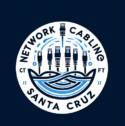How Do Cables Transfer Data? A Simple Guide to How Your Network Actually Works
Have you ever wondered how cables transfer data between your computer, router, or smart devices? Whether you’re streaming a movie, uploading files to the cloud, or making a video call, data is constantly moving — and cables are the invisible highways that make it all happen.
In this guide, we’ll break down exactly how data travels through cables, the science behind it, and why quality cabling matters for speed and reliability. Our team of structured cabling experts in Santa Cruz ensures every installation supports efficient data transfer and long-term reliability.
What Does “Transferring Data” Really Mean?
When we talk about data transfer, we’re referring to the process of sending digital information — such as text, video, or audio — from one device to another. These data bits are represented as electrical or light signals that move through physical cables, depending on the cable type.
In simple terms:
Your devices convert information into tiny signals → cables carry those signals → the receiving device decodes them back into usable data.
The Science Behind How Cables Transfer Data
There are two main ways cables send data:
1. Electrical Signals (Copper Cables)
Most traditional network cables — like CAT5e, CAT6, and CAT6a — use electrical pulses to transmit binary data (1s and 0s). Each pulse represents a bit of information, and twisted pairs of copper wires inside the cable help reduce interference.
These signals travel at nearly the speed of light, though slightly slower due to resistance in the copper wire.
Examples:
- Ethernet cables used in homes and offices
- HDMI cables connecting TVs and media devices
- USB cables connecting computers and peripherals
2. Light Signals (Fiber Optic Cables)
Fiber optic cables use light pulses instead of electricity to transmit data. Inside, strands of glass or plastic fiber carry data as beams of light reflected through the cable’s core.
Because light travels faster and isn’t affected by electromagnetic interference, fiber optics offer higher speeds, longer distances, and greater reliability than copper.
Examples:
- Internet backbone connections
- Data centers and enterprise networks
- High-speed telecommunications systems
What Happens Inside a Data Cable
No matter the type, every data cable has similar components that make data transfer possible:
- Conductors or fibers – The pathways that carry electrical or light signals
- Insulation – Protects the signal and prevents data loss
- Shielding – Blocks electromagnetic interference from nearby devices
- Jacket – The outer layer that protects the cable from damage and wear
In copper cables, data travels through pairs of twisted wires — each pair carries signals in opposite directions to minimize interference. In fiber optics, light signals bounce within the core using total internal reflection, maintaining signal strength over long distances.
How Devices Communicate Through Cables
When you plug a cable between two devices, both ends must speak the same “language” — a set of rules called network protocols.
For example:
- Ethernet defines how data is formatted and transmitted over copper or fiber cables.
- USB governs how data is exchanged between a computer and a connected device.
- HDMI transfers both audio and video signals for media systems.
Each protocol ensures that the sending and receiving devices understand each other’s signals without corruption or loss.
Why Cable Quality Matters
Not all cables are created equal. Poor-quality or damaged cables can cause:
- Slower data transfer speeds
- Intermittent connection drops
- Increased signal interference
- Data errors or loss
For the best performance, always choose certified and properly rated cables (such as CAT6 for networking or high-speed HDMI 2.1 for 4K video) — especially if you’re transferring large amounts of data or working in professional environments. Factors like material quality and cable size can significantly influence how well data travels across a network.
Copper vs. Fiber: Which Is Better for Data Transfer?
| Feature | Copper (Ethernet) | Fiber Optic |
|---|---|---|
| Signal Type | Electrical | Light |
| Speed | Up to 10 Gbps (CAT6a) | Up to 100 Gbps+ |
| Distance | Up to 100 meters | Several kilometers |
| Interference | Susceptible | Immune |
| Cost | Lower | Higher |
| Ideal Use | Homes, small offices | Large enterprises, long-distance connections |
Both cable types are excellent when used in the right context — copper for shorter, cost-effective installations and fiber for high-speed, long-distance connectivity.
Everyday Examples of Data Transfer Through Cables
Here’s how cable-based data transfer impacts your daily life:
- Internet browsing: Ethernet cables connect your modem and router for faster speeds.
- Streaming video: HDMI cables carry HD and 4K video from devices to TVs.
- File sharing: USB-C cables transfer files between laptops, phones, and external drives.
- Surveillance systems: CAT6 cables deliver video and power to security cameras.
Every one of these activities relies on precise, fast, and reliable data transfer.
Future of Data Transmission
Technology continues to evolve. We’re seeing hybrid cabling (copper + fiber), higher-speed Ethernet (Cat8), and even optical USB technologies on the rise. As bandwidth demands grow, cable systems are becoming smarter, faster, and more energy-efficient.
The future points toward fiber optic dominance, but copper will still play a role in cost-sensitive and short-distance applications.
Final Thoughts
Data cables are the unsung heroes of modern communication. They make it possible for our devices to share information at lightning speed, keeping businesses, homes, and the internet connected.
Whether you’re using Ethernet, HDMI, USB, or fiber, understanding how these cables transfer data helps you make smarter choices when setting up or upgrading your network. Different cables offer varying data rates depending on their category and construction — learn more about the maximum speed of a network cable.
For the best performance, always invest in quality cables and professional installation, especially for complex setups or large buildings.
